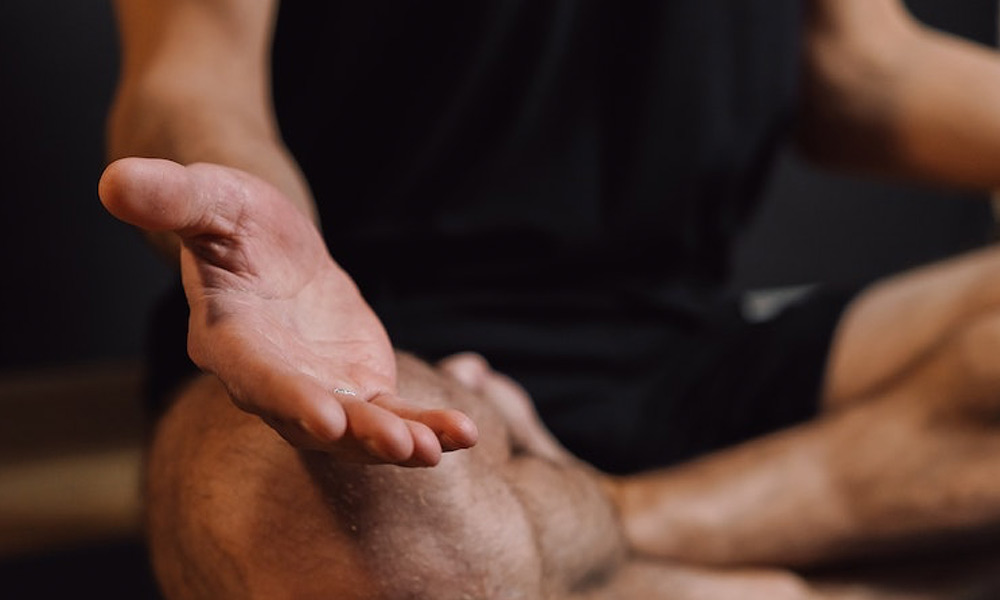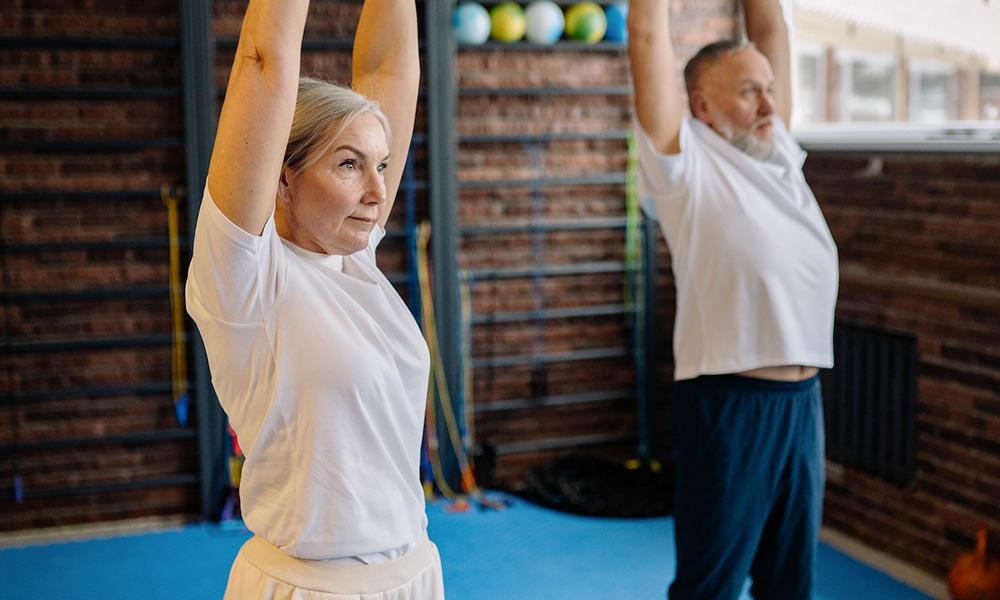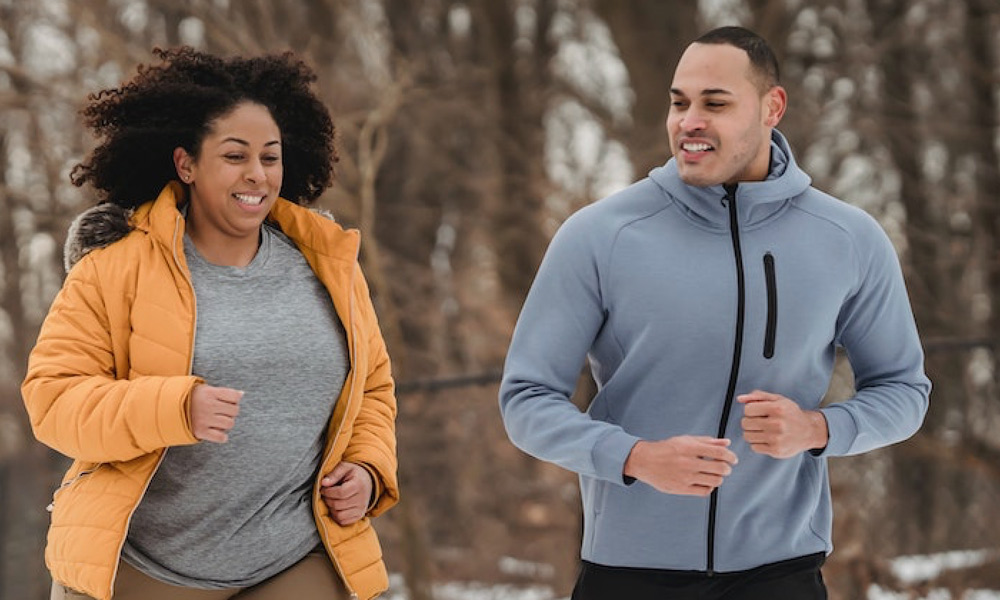For some people, exercising is a chore that they need to talk themselves into, while others are constantly looking for the next challenge. Whether you need more motivation for moving your body or you’re looking for new activities to try with your significant other, learning workouts to do with your spouse can inspire you both to try something new. Plus, these workouts can help you gain major physical and cognitive health benefits! You’re also more likely to commit to your wellness journey with some accountability.
Having a consistent workout partner encourages you to get your body moving more often than just doing it alone. Here are 15 suggested workouts to try with your partner ASAP. Ready, set, and work out with your spouse!
Beginner Level
Even though the first few exercises we’ll suggest are more rudimentary, they’re still fundamental to building a solid fitness habit. As long as you’re moving your body, you’re making meaningful progress. With time, you can work your way up to greater challenges—you are never stuck, you can always keep growing.
Take A Stroll
Walking tends to be overlooked, but it is a great resource and an excellent starting place for working out with your spouse. New research suggests that simple, low-impact walking has a major impact on cardiovascular health, and more and more data supports this assertion.
Try Out a Dance Class
Ballet, jazz, hip-hop, bachata—the list goes on! Find a genre that you and your spouse are interested in and give a dancing class a chance! If you want more practice or feel like staying in, find some videos online to follow along to help build your confidence levels!
Get In Some Abdominal Workouts
Sit-ups, crunches, and heel touches are some nice starter ab routines you and your partner can try together.
Discover a New Hiking Trail
Going on a hike doesn’t necessarily mean trudging up mountains. Search online for hiking spots near you and check out the intensity levels and reviews. Alltrails is a fantastic resource for selecting a hike that matches your goals. Choose the one that best fits you and your spouse’s comfort level.
Stretch Together
Surprisingly, you can break a sweat from stretching alone! One stretch you could try is to face each other, legs apart, and feet together. Hold each other’s hands and lightly pull back and forth.
Grab Some Clubs and Golf
While the game itself can move slowly, walking the course and learning the techniques can train your body in incredible ways, like loosening your shoulders and increasing your cardiovascular health.
Intermediate Level
If you’re feeling a little more adventurous, here are some ideas to throw into your next active day.
Go for a Jog or a Run
If you and your partner enjoy an activity that increases your heart rate, take some laps around the block. Make it a friendly competition and compare your splits and mile times.
Increase the Intensity of Your Ab Workouts
Take your ab training up a level and attempt more challenging moves, including:
- Plank High-Fives
- Position yourselves in a plank position. Alternate your arms by giving each other high-fives.
- Lying Leg Lifts and Throwdowns
- Lay on the ground with your legs straight up. From there, your partner stands over you, facing your legs, and holds your ankles. Your partner “throws” your feet toward the ground and you lift them back up. Repeat as many times as you can!
- Medicine Ball Sit-ups
- Start with basic sit-ups, but add throwing a medicine ball back and forth each time you come up.
Get Flexible with Yoga
Yoga is substantial for flexibility and overall movement. Challenge each other to new positions and always acknowledge each other’s improvement.
Give Tennis a Chance
Tennis is an intense aerobic recreation. If you’re feeling up to it, hit the court as a pair. However, if you’re looking for a way to ease into the sport, consider recruiting an additional couple to play in teams!
Take a Spin in Some Skates
It may be seen as a vintage hobby, but if you’re looking to burn calories and work your glutes, rollerblading may be the perfect option for you and your significant other!
Expert Level
Don’t forget to stay fueled through all of your workouts, especially on higher-intensity days!
Challenge Yourself with Crossfit
If you and your partner are interested in improving physical strength, think about integrating some Crossfit workouts into your rotation. Besides gaining balance and endurance, you’ll also obtain a new bonding level with your spouse.
Blow off Some Steam by Kickboxing
If you’re looking for an acceptable way to let out some tension, contemplate joining a boxing class! You and your significant other can tone muscle together while reducing your stress levels.
Reach New Levels by Rock Climbing
Climbing is a perfect option for indoor or outdoor recreation. It’s a full-body workout that can involve heavy communication and support (literally) of each other!
Make a Splash
Put on your goggles and dive in! Swimming is an incredible choice for any workout level because it’s low impact, and you can go at your own pace. Grab a stopwatch if you want to challenge your significant other and increase the pressure of competition.
Remember that trying new workout activities with your spouse should be fun, not discouraging! Don’t get too caught up by the numbers on the scale— listen to your body and pay attention to the way you feel before, after, and during to measure progress. At the end of the day, you’re spending more quality time with your partner while improving each other’s physical lifestyles.
Are You a Cancer Survivor Looking for Guidance With Fitness and Nutrition?
Survivor Fitness is here to provide an extra level of support to help you regain control of your life. If you’re interested in gaining more exercise ideas or achieving fitness goals, contact us today.








